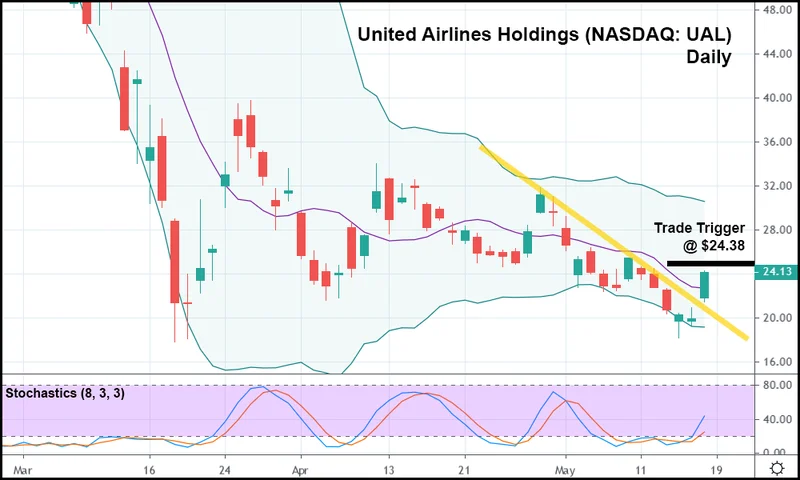United Airlines Stock: What to Expect from Upcoming Earnings
The pre-market hours before an earnings release have a specific kind of silence. It’s not empty; it’s charged with potential energy, the digital equivalent of a held breath. On Thursday, October 16th, that silence will be centered on United Airlines. When the numbers hit the wire, they will resolve months of speculation into a single, brutal, up-or-down verdict.
The consensus estimates paint a picture of a company running hard just to stay in place. Wall Street anticipates earnings of $2.67 per share on revenue of $15.29 billion. Compare that to the same quarter last year: $3.33 in earnings on $14.84 billion in revenue.
Let’s be clear about what that means. The forecast suggests United is successfully getting more people onto its planes and charging them more money, yet it’s keeping less of every dollar it brings in. That’s a classic margin compression story, and it’s the kind of narrative that makes investors nervous. But with United, the story is more complex. The market’s reaction to its earnings isn’t just about one quarter’s numbers; it’s about a deeply ingrained pattern of behavior that the data makes impossible to ignore.
The Market's Peculiar Habit with United
When you look at a company with a $33 billion market cap and $58 billion in annual revenue, you expect a certain level of predictability. Yet, United’s post-earnings stock performance has been anything but. My analysis of the last five years of data reveals a startlingly negative bias. Following an earnings announcement, UAL’s stock has ended the next day in the red 53% of the time.
This isn’t a coin flip. It’s a trend with teeth.
The severity of the reaction is even more telling. The median negative one-day return over that period was a drop of 4.0%. The median positive return, by contrast, was 5.3%. On the surface, that might seem reasonably balanced, but it’s the outliers that tell the story. The worst single-day drop was a staggering -10.2%. This suggests the market acts like a particularly harsh professor when grading United’s homework: it punishes failures with brutal, sweeping cuts, but hands out rewards with a begrudging reluctance. The risk, historically, has been skewed sharply to the downside.

I’ve looked at hundreds of these filings, and this particular reaction profile is unusual for a legacy carrier of this size. It points to a persistent disconnect between the company’s operational reality and the market’s expectations. What is it about United’s story that invites such skepticism? Is management consistently over-promising, or are analysts fundamentally misreading the headwinds this industry faces?
To be fair, the data from the last three years shows a slight improvement, with the frequency of positive one-day returns ticking up to 58%. This could signal that CEO Scott Kirby and his team are slowly getting better at managing Wall Street’s expectations. But is a handful of quarters enough to break a five-year habit? I’m not convinced. The underlying dynamics that created the negative bias haven’t disappeared.
Reading the Tea Leaves for October 16th
This brings us back to the upcoming report. The forecast for lower earnings on higher revenue is the perfect catalyst to trigger the market’s old anxieties. The revenue growth, at about 3% year-over-year, is fine. It’s not spectacular, but it shows demand remains intact. The problem is the projected drop in earnings per share. The profit decline is about 20%—to be more exact, 19.8% year-over-year. That’s a significant erosion of profitability.
This isn’t a mystery. The culprits are well-known: climbing labor costs (a direct result of hard-fought union negotiations across the industry), volatile jet fuel prices, and the immense capital expenditures required to modernize an aging fleet. United is spending billions on new aircraft, a necessary long-term investment that weighs heavily on the short-term balance sheet.
So, the central question for October 16th isn’t whether United can grow revenue. It’s whether they can control costs. The earnings number will be the entire story. Any miss on that $2.67 per share consensus, or any guidance that suggests margins will continue to shrink, could easily reactivate that historical -4.0% median drop. The market has shown, time and again, that it has very little patience for excuses when it comes to United’s bottom line.
This is the part of the analysis that I find genuinely puzzling. The market is an expectations machine. The headwinds facing United are not secrets; they are discussed ad nauseam on every conference call and in every analyst report. Yet the stock continues to react with such surprise and disappointment. Why does the negative part of the equation (margin pressure) seem to carry so much more weight than the positive part (strong travel demand)? Will this be the quarter that the narrative finally shifts, or will the company find itself once again explaining why flying more people is somehow making them less money?
The Gravity of Expectations
Ultimately, this isn't just about the numbers United prints on October 16th. It's about a five-year track record that has conditioned investors to be skeptical. The data suggests a company walking a tightrope, where even a slight wobble in profitability can lead to a significant fall. The mixed forecast of higher sales but lower profits is the exact scenario that has historically triggered a sell-off. Until the company can prove it has a permanent handle on its cost structure, the data-driven bet remains that the market's old habits will die hard. The odds favor gravity.
Tags: ual stock
The ABAT Stock Surge: Why It's Rising, Its Future Potential, and the Community Buzz
Next PostWhat the Hell Is Happening in Toronto?: A Rundown of the Explosions, Trials, and General Mayhem
Related Articles
